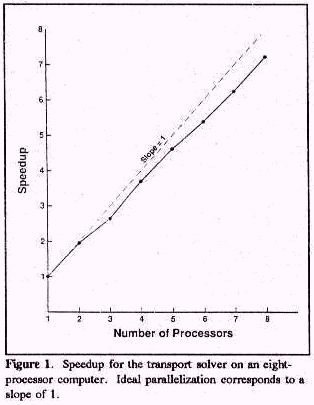Wyoming Water Resources Center

|
RESEARCH BRIEFS Wyoming Water Resources Center |

|
| Technical RB92-03 |
Investigator: Myron B. Allen, Department of Mathematics, University of Wyoming.
Purpose: Computer models of groundwater flow and contaminant transport are important tools in designing aquifer cleanup schemes. Models also aid in the investigation of poorly understood aspects of underground flows. Examples include the spread of contaminants by random velocity variations and the effects of measurement uncertainty on model predictions. Both applications --- the practical and the theoretical --- require more efficiency and accuracy than standard models provide. This research focuses on better numerical methods for such models.
Methods:
Groundwater models are based on differential equations. The solutions to
these equations give the water velocity, pressure (or head), and contaminant
concentrations. For real aquifers, it is usually impossible to solve the
 equations exactly. Instead, engineers use complex computer codes to generate
approximate solutions. Most codes employ finite differences or finite
elements, which partition aquifers into cells and compute local mass and
momentum balances. These discrete techniques require billions of arithmetic
operations, taking hours or days to run on supercomputers.
equations exactly. Instead, engineers use complex computer codes to generate
approximate solutions. Most codes employ finite differences or finite
elements, which partition aquifers into cells and compute local mass and
momentum balances. These discrete techniques require billions of arithmetic
operations, taking hours or days to run on supercomputers.
Careful studies, involving the world's most thoroughly measured contamination sites, show that standard models are often too inaccurate to be realistic, even when good site data exist. Especially troublesome are heterogeneous sites, where rock properties vary over several orders of magnitude.
Two approaches help overcome these difficulties. First, proper discrete techniques can maximize the accuracy available for a given number of arithmetic operations. Second, new solution algorithms can reduce numerical sensitivity to heterogeneity. Also, well designed algorithms can exploit the emerging generation of fast, parallel-architecture computers.
Results: For the flow equations a technique called mixed finite elements produces accurate water velocities, unlike standard methods that numerically differentiate accurate heads to compute inaccurate velocities. A multigrid algorithm solves the approximations rapidly and in parallel, even when heterogeneity forces modelers to use extremely small cells for resolution.
A technique called alternating-direction collocation yields highly accurate solutions to the transport equation. The technique works well on parallel machines, and it admits embellishments that make is suitable for high-velocity flows. Among these are timestepping along natural contaminant paths (method of characteristics) and adaptively locating small cells to resolve moving contaminant fronts (local grid refinement).
Future Work: One can extend the techniques to accommodate more complicated physics. Of special interest are tensor rock properties and the nonlinearities associated with nonaqueous contaminants. Other research involves new scaling rules for aquifer properties. These rules translate hydrogeologic data to the scale of cells used in field-wide models.
Publications:
Allen, M.B., and M.C. Curran. 1992. "A multigrid-based solver for mixed finite-element approximations to groundwater flow", in Numerical Methods in Water Resources, ed. By T. Russel et al.Elsevier, London. pp579-585.
Allen, M.B., R.E. Ewing, and P. Lu. 1992. "Well conditioned iterative schemes for mixed finite-element models of porous-media flow". Journal of Society for Industrial and Applied Mathematics. 13(3):794-814.
Allen, M.B., and A. Khosravani. "Solute transport via alternating-direction collocation with a Modified method of characteristics". Advanced Water Resources. (forthcoming).
S. Smith, M. Allen, J. Puckett, and T. Edgar. 1992. "The finite-layer method for groundwater flow models". Water Resources Research. 28(6): 1715-1722.
| For further information on this or other research projects or for a list of WWRC publications, telephone or write: |
Wyoming Water Resources Center P.O. Box 3067, University of Wyoming Laramie, WY 82071-3067 (307) 766-2143; FAX (307) 766-3718 |
WWRC RESEARCH BRIEFS are published by the Wyoming Water Resources Center with funds provided in part by the US Geological Survey, Department of Interior, as authorized by the Water Resources Research Act of 1984. The research on which this report is based was financed in part by the US Geological Survey, Department of Interior and Wyoming Water Resources Center. The views expressed do not necessarily represent those of the Department of Interior or the WWRC. Persons seeking admission, employment, or access to programs at the University of Wyoming shall be considered without regard to race, color, national origin, sex, age, religion, political belief, handicap, or veteran status.
 |
Technical RB92-03 |
Research Briefs List
Water Resources Data System Library |
Water Resources Data System Homepage